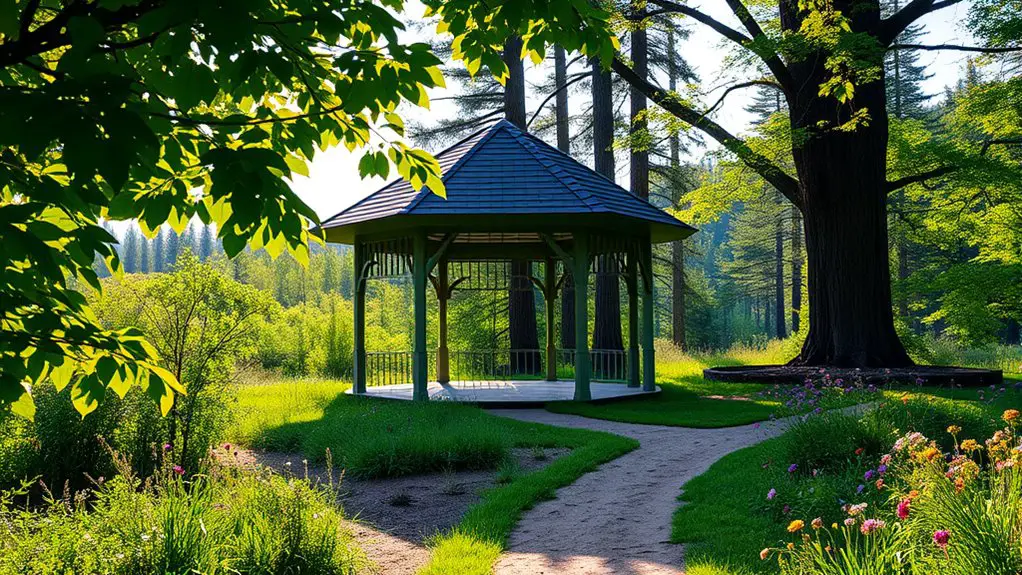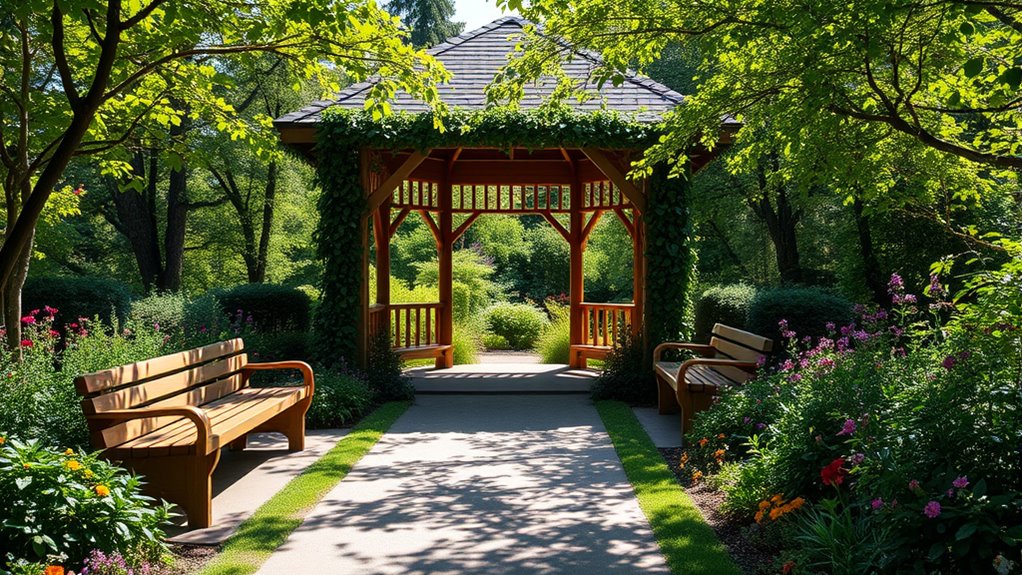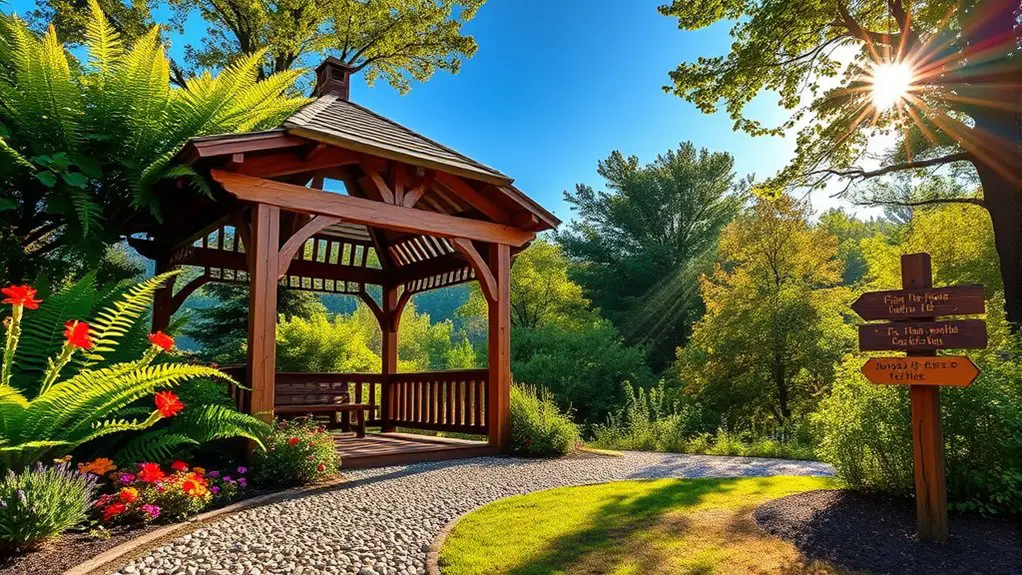Setting up a nature walk from your gazebo is a wonderful way to connect with the outdoors. Start by evaluating your space for hazards and natural beauty. Choose materials that blend well with the environment for your path. Incorporate seating areas to enjoy scenic views and enhance the experience with colorful plants and signage that informs visitors about local wildlife. If you want to discover additional tips on creating the perfect nature walk, keep exploring further.
Assessing Your Space and Surroundings

Before you step out into nature, it’s essential to assess your space and surroundings, ensuring you’re fully prepared for the experience ahead. Start with a thorough space evaluation; look around your gazebo to recognize any potential hazards like uneven terrain or low-hanging branches. Pay attention to the surrounding wildlife, too. Are there any birds flitting about or deer grazing nearby? Knowing what creatures inhabit your space can enhance your journey, helping you appreciate the vibrant ecosystem around you.
Take a moment to breathe in the scents of the earth and listen to the sounds of rustling leaves or chirping insects. This awareness not only heightens your senses but also connects you to the wild. By evaluating your space and understanding the wildlife, you’ll cultivate a sense of freedom that invites you to explore deeper into nature’s embrace. Embrace the adventure; it’s waiting just outside your door.
Choosing the Right Path Materials
As you consider the path materials for your nature walk, it’s important to balance aesthetics with functionality. You want your path to complement the natural beauty around your gazebo while also being durable and easy to maintain. Gravel options, for instance, are a popular choice, offering excellent drainage and a rustic feel. If you’re leaning toward eco-friendly materials, consider using decomposed granite or recycled rubber mulch, which not only looks great but also minimizes your environmental footprint.
Here’s a quick comparison:
| Material | Aesthetics | Eco-Friendliness |
|---|---|---|
| Gravel Options | Rustic and natural | Moderate |
| Decomposed Granite | Earthy and elegant | High |
| Recycled Rubber Mulch | Colorful and unique | Very High |
Ultimately, the right materials will create a welcoming path that invites exploration and reconnects you with nature.
Designing Your Walking Path

While envisioning your walking path, it’s essential to contemplate how its design can enhance the overall experience of your nature walk. A well-thought-out pathway not only invites exploration but also harmonizes with its surroundings.
Consider these key aspects:
- Pathway Aesthetics: Choose colors and materials that blend with nature, creating a seamless shift from your gazebo to the wild.
- Terrain Considerations: Assess the land’s natural contours and features, ensuring your path is both functional and visually appealing.
- Accessibility: Design the path to accommodate all walkers, allowing everyone to enjoy the journey. Additionally, ensure the path follows ideal placement that considers privacy, sun exposure, and wind direction for a more enjoyable experience.
Incorporating Natural Features
To create a truly immersive nature walk, you should consider how to incorporate the natural features of your landscape into the design of your path. Embrace the existing terrain—whether it’s rolling hills, dense woods, or shimmering streams. These elements not only enhance the visual appeal but also create diverse natural habitats for local wildlife.
Think about weaving your path through vibrant flower beds or alongside tall grasses, which attract butterflies and bees. Place interpretive signs along the route to encourage wildlife observation, allowing you to connect with nature on a deeper level.
Adding Seating and Rest Areas

A well-placed bench or seating area can transform your nature walk into a true sanctuary. By incorporating thoughtful seating options, you invite relaxation and reflection into your outdoor experience. Consider these elements for your rest area design:
- Natural Materials: Use wood or stone that blends seamlessly with the environment.
- Scenic Views: Position benches to overlook beautiful landscapes, encouraging a sense of tranquility.
- Shade and Shelter: Create areas that provide respite from the sun or rain, making your walk enjoyable in any weather.
These features not only enhance your nature walk but also offer a place to pause and breathe. Adding a well-designed structure can further enhance the functionality and aesthetics of your outdoor space. Whether you want to sip coffee while listening to birds or simply take a moment to revel in your surroundings, these seating areas will enrich your journey. So, go ahead—design your sanctuary and let nature’s beauty unfold around you!
Enhancing the Path With Plants and Flowers
Once you’ve established serene seating areas, the next step is to enhance the path itself with vibrant plants and flowers that draw you deeper into nature’s embrace. By incorporating native plants, you’ll not only support local wildlife but also create a low-maintenance landscape that thrives. Seasonal flowers can add bursts of color throughout the year, inviting you to explore. Consider adding climbing plants to your gazebo to provide natural shade and further enhance the beauty of your surroundings.
Here’s a quick visual representation of ideas for your path:
| Native Plants | Seasonal Flowers |
|---|---|
| Coneflower | Marigolds (Summer) |
| Black-eyed Susan | Daffodils (Spring) |
| Lavender | Chrysanthemums (Fall) |
Planting in clusters can create visual interest and entice butterflies and bees. So, as you stroll along, let the fragrance and beauty of your carefully chosen flora guide your senses, encouraging a deeper connection with nature.
Installing Lighting for Evening Walks
As the sun sets, illuminating your walkway can transform evening strolls into a magical experience. You’ll want to choose light fixtures that not only enhance the path’s beauty but also provide safety and comfort. Consider energy-efficient options that brighten your space while keeping your energy bills in check, allowing you to enjoy those twilight walks guilt-free. Incorporating LED lights can offer both longevity and energy savings, making them a smart choice for your outdoor lighting needs.
Choosing Appropriate Light Fixtures
When planning your evening nature walks, the right light fixtures can transform your experience, creating a safe and inviting atmosphere. Consider these options to enhance your strolls:
- Solar Lanterns: Embrace the beauty of eco-friendly lighting that charges by day, illuminating your path at night.
- Pathway Illumination: Strategically placed lights can guide your steps, ensuring you don’t trip over roots or stones.
- Ambient Lighting: Soft, warm lights create a cozy vibe, encouraging relaxation and connection with nature.
Energy-Efficient Lighting Options
Choosing the right lighting fixtures sets the stage for your evening nature walks, but energy-efficient options can elevate your experience even further. Solar lanterns are a fantastic choice, casting a warm, inviting glow while harnessing the power of the sun. They’re easy to place along your path, creating a magical ambiance without impacting your energy bill.
For more versatility, consider LED strips. These flexible lights can be installed discreetly along railings or pathways, illuminating your route without overpowering the natural surroundings. Plus, they’re long-lasting and consume minimal energy. By opting for these eco-friendly solutions, you’ll not only enhance your evening strolls but also embrace a lifestyle that values sustainability and freedom in nature. Embrace the beauty of your surroundings as the sun sets!
Creating Signage and Markers
As you plan your nature walk, choosing the right signage materials can enhance the experience for everyone who joins you. Think about where you’ll place your markers to guide visitors along the path, ensuring they’re both informative and easy to spot. With thoughtful signage and strategic placement, your walk will become an inviting adventure through nature’s beauty.
Choosing Signage Materials
While exploring the natural beauty surrounding your gazebo, you’ll want to guarantee that your signage and markers effectively guide visitors and enhance their experience. Choosing the right signage materials is essential, especially since they need to withstand the elements. Look for durable options that blend seamlessly with nature while standing the test of time. Consider:
- Wooden Signs: Eco-friendly and rustic, they provide a warm, inviting feel.
- Metal Markers: Strong and weather-resistant, they’re perfect for long-term use.
- Recycled Plastic: Durable and sustainable, they offer a modern touch while being kind to the environment.
Placement of Markers
Effective placement of markers can make all the difference in your nature walk experience. Think about using various marker types, like directional signs, informational plaques, and whimsical trail markers. Strategically position these along your path to guide wanderers seamlessly. Place directional signs at forks or intersecting trails, ensuring they’re visible from all angles. Informational plaques can be nestled near interesting flora or fauna, sparking curiosity about the environment. For a touch of fun, use unique trail markers like painted stones to encourage exploration. Remember, clarity is key—make sure your markers are easy to read and understand. With thoughtful placement strategies, you can create an inviting and engaging nature walk that inspires freedom and connection with the great outdoors.
Maintaining Your Nature Walk Over Time
To guarantee your nature walk remains a tranquil retreat over time, regular maintenance is essential. Embracing long-term maintenance guarantees your path stays inviting and vibrant, allowing you to enjoy nature’s wonders without hassle. Consider the following:
- Seasonal Updates: Adjust your walk for changing seasons by planting native flowers that bloom throughout the year.
- Pathway Care: Regularly clear debris and repair any erosion to maintain a safe and pleasant walking route.
- Wildlife-Friendly Enhancements: Add birdhouses or feeders to attract wildlife, enriching your experience with delightful visitors.
Frequently Asked Questions
What Should I Wear for a Nature Walk?
For your nature walk, wear comfortable footwear to guarantee ease while exploring. Consider the weather—light layers if it’s cool or breathable fabrics for warmth. Don’t forget a hat and sunscreen to protect from the sun!
How Long Should My Nature Walk Be?
For your nature walk, aim for an ideal distance of 1 to 3 miles. Consider age and fitness levels; shorter walks are perfect for kids or older adults, ensuring everyone enjoys the experience without feeling overwhelmed.
Can I Bring Pets on the Walk?
Imagine your dog’s joy, bounding through the trees. Yes, you can bring pets, but remember leash requirements and pet-friendly tips. Keep your furry friend safe while exploring nature’s wonders together; freedom feels better with them by your side.
What Safety Precautions Should I Take?
When planning your walk, consider carrying first aid and emergency supplies. A small kit can make all the difference. Stay aware of your surroundings, and let someone know your route for added safety and peace of mind.
How Do I Attract Wildlife to My Path?
To attract wildlife to your path, consider adding wildlife feeders filled with seeds and using native plants that provide food and shelter. These elements create a welcoming habitat, encouraging birds and critters to thrive nearby.

